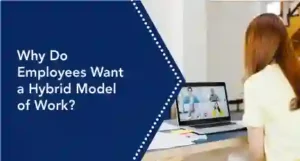Hybrid workspaces: Addressing the challenges faced by organizations

Table of contents
The future of work has spoken; for the immediate time or even beyond, hybrid work is going to be the norm for many organizations. After spending months working from home, and getting used to it, many employees are excited about flexible work methods. In fact, according to a 2021 Gartner study, 52% of employees would decide whether or not to work for a company based on flexible work policies, and 16% said they’d consider quitting if their profile required them to go to work onsite.
Several companies have taken this into account and are allowing their employees to continue working remotely or shift to a hybrid model of work. However, many, such as Amazon, Disney and Starbucks, are actually heading in the opposite direction. These companies have asked their employees to come back to office, fearing loss of communication and collaboration, as well as lowered productivity.
Is there merit in their concerns or are their fears unfounded?
Here are a few challenges of the hybrid working model faced by companies struggling to manage a team of hybrid employees. Remember, these are some of the most common obstacles, but it doesn’t mean that you’ll face these hybrid work challenges too.
Building the perfect remote and on-site work model
Like we mentioned earlier, many companies are requesting employees to come back to work. We don’t believe that’s the best idea today. For most workers, flexible work arrangements are no longer an option, and they will quickly jump to another job that is more open to hybrid working.
So, does this mean that if you simply offer an option to come in some days and work from home the rest of the week, you’re sorted? Unfortunately, it’s not that simple. Different industries, companies, and teams require a different approach. What works for one might not necessarily work for the other. You will need to consider all aspects of your work and needs of your workforce before implementing a hybrid work strategy. Here are a few things to keep in mind.
Creating a strong corporate culture
One of the first victims of a hybrid work structure is the loss of corporate culture. If people aren’t all coming on-site as earlier, how can you build and promote corporate values? A loss of workplace connection is another fallout of remote work.
Solution: Take inputs and feedback from employees while building your hybrid work model. If remedies aren’t taken to correct these aspects, employees are likely to start feeling a disconnect between their work, their colleagues and the company itself, leading to frustration.
Managing a hybrid team
Even with the same people, leading a remote, hybrid, or distributed team is quite different from managing one where leaders meet people in-person every day. While adjustments need to be made from both sides, the onus is on the manager to promote remote work best practices and to imbue an employee-centric approach to make it work.
Solution: Using AI tools can help manage teams better. Besides improving efficiency and productivity, these tools can also tell managers who is working where and when. When employees’ needs and well-being are prioritized, it can reduce human errors and improve collaboration between teams.
Also Read: Hybrid Working Model is Here to Stay – Doing Hybrid Right!
Establishing fair and inclusive work practices
Hybrid working can raise concerns about biases creeping into the environment. Studies have shown that 41% of employees feel that remote workers don’t get equal opportunities for career growth. On the flip side, managers could wrongly believe that on-site workers work harder than remote employees.
Solution: Managers can create open channels for communication between employees and higher-ups. By putting adequate emphasis on providing regular progress updates, concerns of unfair treatment and favoritism at the workplace can be reduced.
Dealing with mental health issues and burnout
In most cases, flexible work hours have been shown to have a positive impact on employee morale and mental health. However, it can also have the opposite effect in some cases. For example, if there’s no clear hybrid work policy and the office fails to provide the right tools for work, employees could struggle to perform to their best abilities, leading to frustration and burnout.
Solution: Managers can lead by example. Set clear work expectations, and ensure there are distinct work and personal life boundaries. When leaders avoid micromanagement practices, there will be an improvement in overall morale.
Maintaining high cybersecurity
With remote employees, security is a greater concern due to weaker internet connections and personal equipment. Remote working can create a backdoor for hackers looking to exploit a weak link in your operations and access private, confidential data.
Solution: Deploy updated security tools and look for solutions that can seamlessly integrate into existing systems, at remote locations and in the workplace.
Solutions to overcome challenges of hybrid work
These hybrid work challenges might seem difficult to overcome, but with a little effort, you can find solutions. Here’s a quick look at the aforementioned hybrid working challenges and solutions for each.
Hybrid Work Challenges | Hybrid Work Solutions |
| Creating a strong corporate culture | Take inputs and feedback from employees while building your hybrid work model |
| Managing a hybrid team | Use AI tools to manage teams, increase efficiency and productivity, reduce human errors and improve collaboration between teams |
| Establishing fair and inclusive work practices | Create channels for communication and provide regular progress updates |
| Dealing with mental health issues and burnout | Set clear work expectations and ensure there are work boundaries |
| Maintaining high cybersecurity | Update security tools and look for solutions that can seamlessly integrate into existing systems |
Yes, hybrid working arrangements can be daunting for those looking to adapt to the new normal, and even challenging for those who have already migrated there. But with these tips, leaders can tackle some of the most common challenges of hybrid working and find ways to make their hybrid working model a success.



